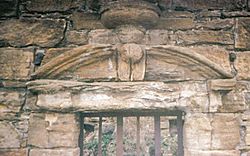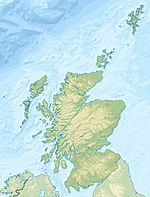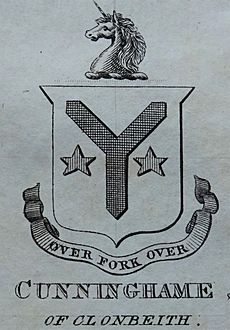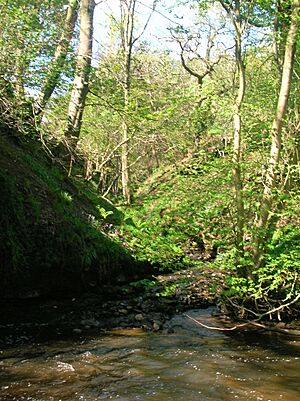Clonbeith Castle facts for kids
Quick facts for kids Clonbeith Castle |
|
|---|---|
| Auchentiber, North Ayrshire, Scotland UK |
|

The front entrance of Clonbeith Castle showing ashlar and freestone on what may have once been a harled surface.
|
|
| Coordinates | 55°40′30″N 04°38′38″W / 55.67500°N 4.64389°W |
| Site information | |
| Owner | Clonbeith Farm |
| Controlled by | Cunningham clan |
| Open to the public |
Private |
| Condition | Ruined |
| Site history | |
| Built | 17th century |
| In use | Until 18th century |
| Materials | stone |
The Castle of Clonbeith is an old ruined castle. You can find it near Auchentiber in North Ayrshire, Scotland. It sits on a side road off the B778. This area was once known as the Baillerie of Cunninghame.
The name 'Clonbeith' might come from old Celtic words. 'Cluan' means 'grazing land' and 'Beithe' means 'birch tree'.
Contents
What Did Clonbeith Castle Look Like?
Clonbeith Castle was a simple, rectangular building. It measured about 40 feet long and 23 feet wide. Its walls were very thick, about two and a half feet!
The ground floor had a vaulted ceiling. This means it had a curved, arched roof, like a tunnel. The main door was in the middle. It led into a hallway. From there, a straight staircase went up to the first floor. This floor held the main hall.
A special spiral staircase, called a wheel-stair, led to the upper floors. The main hall had windows on three sides. It also had a large fireplace. On the opposite side, there was a round, curved window. This window stuck out from the wall. It was supported by stone brackets called corbels. The main door has the year 1607 carved into it. This shows it was built in the Renaissance style.
Who Owned Clonbeith Castle?
In the 1690s, the castle was known as 'Klonbyith'. It belonged to William Cunningham. He was part of a branch of the powerful Glencairn Cuninghame family. This branch came from the Aiket Castle family. William's wife was Agnes, who passed away in 1612.
Records from 1691 show that 'Clonbeith House' had five fireplaces. This tells us it was a fairly large home for its time. Many other homes were connected to the main house.
The Cunningham family of Clonbeith sometimes spelled their name differently. You might see it as Cunningham, Cunninghame, or Cuningham.
Important Owners of Clonbeith
In 1633, Daniel Cunningham sold the castle. His son William agreed to the sale. They sold it to James Scott, who was the Provost (like a mayor) of Irvine.
Later, in 1691, James's brother Walter sold the land. It was bought by Patrick Warner. He was a minister in Irvine.
In 1698, another part of the family, Hugh Cuninghame of Clonbeith, bought the Monkredding estate. This estate then became the main home for his family.
A Historical Event
In 1586, a man named John Cuningham was involved in a serious event. He was with about 30 other people. They were involved in the death of Hugh, the fourth Earl of Eglinton. John Cuningham was later found hiding at Hamilton Palace. He was then killed by Robert, Hugh's brother, and his supporters. People at the time said Robert "honourably revenged" his brother's death.
Spooky Stories of Clonbeith
The Lady of Clonbeith
There's a ghost story about the 'Leddy o'Clumbeith'. It was first told by Dr. Duguid in the 1820s. The story says a servant girl from Clonbeith farm was going to meet someone. She was on her way to the Blair Tavern. But she fell into an old mine shaft, along with her horse, and died. Some people say her boyfriend killed her. Then he jumped into the shaft after her. People say her ghost still walks the fields around Auchentiber.
The Lady in the Peat
Dr. Duguid also shared another strange story from the 1840s. He met a man named Pate Glunch cutting peat near Clonbeith. Peat is a type of soil used as fuel. Pate was usually quiet, but this time he was very excited. He showed the doctor a body in a peat bog. It was a "bonnie lady" who had been dead for a long time. She looked about 18 to 20 years old. She still had rosy cheeks and blonde hair. No one knew who she was. But some people thought she might have been from the Montgreenan family.
Clonbeith's Local History
Around 1691, Reverend Patrick Warner bought Clonbeith. He also bought other lands in Irvine. He had returned from living in Holland. He then worked to drain a large area of wet land. This area was called the 'Loch of Irving' or Trindlemoss. Later, it was known as Scott's Loch.
The Cowlinn Burn is a small stream. It flows down to meet the Lugton Water. This is near where Montgreenan Castle or the Bishop's Palace once stood. An old map from 1820 shows a home called Cowlinn nearby. There was also a Clonbeith Mill close by.
In the 1800s, there was a limestone quarry near the castle. There were also homes for the workers. This quarry provided limestone. It was used in local limekilns. These kilns made lime for building and farming.
An interesting stone tool was found at Clonbeith. Mr. Baird Kirkland found it in the 1800s. It was a well-made round and oval stone implement.





